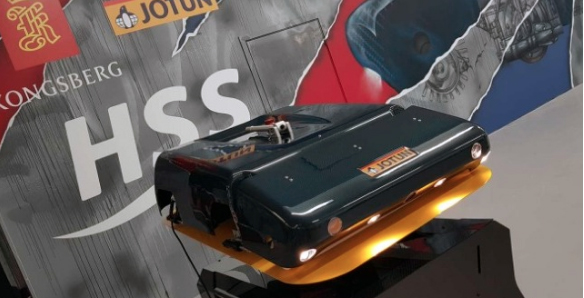Two industry leaders, Jotun and Kongsberg Maritime, partnered to develop a robotic hull-cleaning device called the Jotun HullSkater designed to be carried onboard trips, and deployed regularly to scrub early-stage fouling. The HullSkater removes bacteria and biofilm from the hull before macro-fouling (e.g., barnacles) can take hold. Biofouling is a major contributor to fuel consumption and operating cost, and thus removing it early and often using HullSkater will save shipowners and operators money. This is a new lean and green cleaning machine, the first solution developed for proactive biofouling control on ships. It has the potential to reduce fuel costs by about US$3.6 million, and CO2 emissions by 12.5% annually, on a typical vessel.
Kongsberg Maritime, the market’s leading marine robotics manufacturer, is responsible for the industrialization and manufacturing of HullSkater, which will take place in Horten, Norway. HullSkater will be supported by extended performance and service level guarantees, with global technical support from Jotun and Kongsberg Maritime.
Since 2015, Kongsberg Maritime has contributed to the technology and know-how including development of secure remote-control, cloud-based data storage, battery technology, acoustics, and composite materials as Jotun’s partner on the HullSkater project. HullSkater uses Kongsberg’s global communications infrastructure and Kognifai cloud ecosystem that contribute towards eliminating significant performance losses caused by biofouling, and cancels out waste collection.
“We believe this is a landmark development for shipowners worldwide,” said Geir Axel Oftedahl, Business Development Director, Jotun. “Vessels are often faced with unpredictable operations, erratic idling periods, and varied operational profiles that make selection of antifouling problematic, even for the best coatings. And once fouling grows, the impacts are immediate and damaging, with poor hull and propeller performance accounting for around one tenth of the world fleet’s energy consumption. This can make a massive impact on any owner’s bottom line.”
The HullSkater can stay on the hull using magnetic wheels, each with electric motors for propulsion and steering. It has several cameras and sensors, supporting the operator with data for navigation, and documenting fouling of the ship’s hull. Its motorized brush keeps the hull free from fouling without causing erosion or damage to the hull’s coating. Inspection and a proactive cleaning of a hull would normally take 2-8 hours, depending on vessel size and hull condition. It can stay onboard as a “permanent member of the crew,” and is connected to the operator’s control center through an umbilical cord. It can be operated remotely anywhere in the world with 4G coverage.
Jotun developed a hull coating specifically intended for the use of the HullSkater. Proactive cleaning involves cleaning the hull regularly before hard growth burrows into the hull, and prior to changing geographical bio-environment. Proactive cleaning is less aggressive, causing less damage to both the hull’s coating and the local environment, while helping the vessel reduce fuel consumption. It also reduces the risk of transporting invasive species from one bio-environment to another.
With regard to pollutants and biosecurity risks, the traditional cleaning process leads to damage of the hull coating. There is also the issue of the effect on the environment since the cleaning process usually results in the removed debris sinking to the seabed, or left drifting in the water. Either way has a detrimental effect on local ecosystems.
Traditionally, teams of divers would do the hull cleaning, and this is still being done, but increasingly under scrutiny. Diving teams may be good at clearing the hull’s biofouling but there are problems. It is labor intensive, costly, and subject to diver availability. Thus, many ports do not allow cleaning by divers. And, due to pollutants and biosecurity risks, many complainants are seeking more controls or complete bans. That makes adhering to IMO’s biofouling guidelines more difficult. However, current solutions in the market do not offer the operational flexibility of “anywhere, anytime” cleaning and inspection.
In contrast, the HullSkater can inspect a 10,000m2 hull in about 2 hours. As a permanent member of crew, it is always onboard, ready to clean all fouling at the hull, which if left to accumulate, causes increased drag, leading to extra fuel consumption and emissions to the atmosphere (GHG and CO2).
Alfie Ong, VP, Jotun Marine Coatings, said, “Kongsberg Maritime’s expertise in subsea robotics, remote communications and data management, allied with their dedication to sustainability, made them a perfect fit to partner with us in the development of HullSkater. Together, we have devised a truly innovative solution, which we believe will revolutionize the shipping industry, moving away from traditional, reactive methods of managing fouling, to a proactive approach that will ensure vessels are always operating efficiently and sustainably.”
“We are delighted to offer our 70 years of underwater technology experience as partner with Jotun to develop a solution that can help customers make their businesses safer, more sustainable and more efficient. Conserving our ocean environment and enabling sustainable marine operations is a priority for Kongsberg, and HullSkater offers a uniquely proactive way to solve the difficult problem of fouling growth,” said Egil Haugsdal, President, Kongsberg Maritime.
Simply put, the HullSkater keeps a ship’s hull clean to minimize performance loss with no debris or wastage, giving vessels a low environmental footprint, and operational flexibility.
References:
- New Hull-Cleaning Robot Travels With the Ship. (13-March-2020). The Maritime Executive.
- Jotun Introduces Proactive Cleaning. (13-March-2020). Jotun. https://jointherevhullution.com/
- Jotun and Kongsberg Partnership Delivers Innovative, Proactive and Sustainable Fouling Control. (13-March-2020). Public Now.
